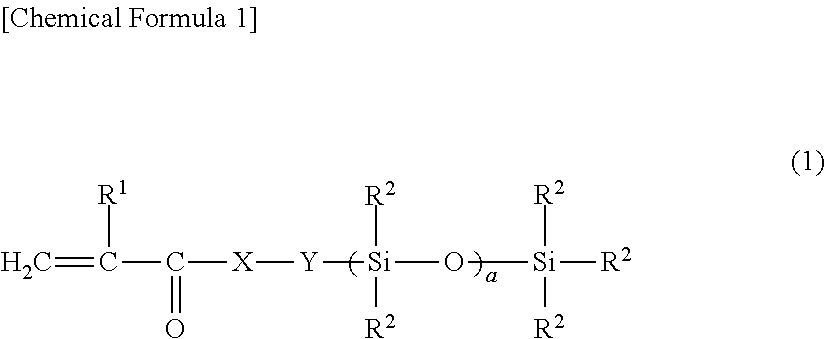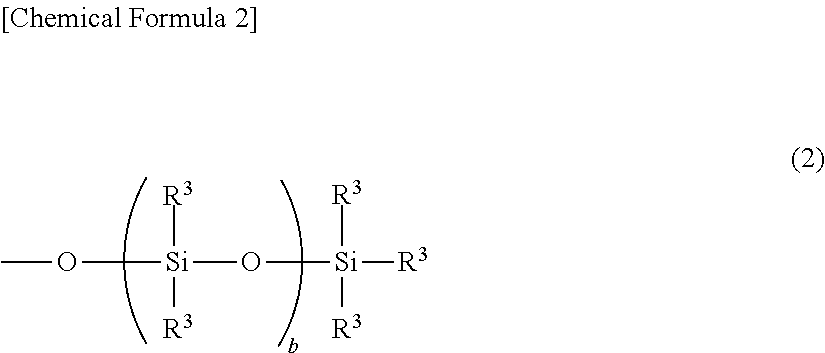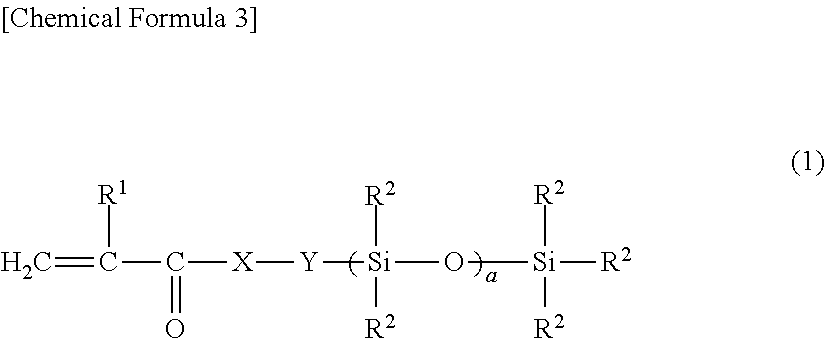Light release additive for release sheet, organopolysiloxane composition for release sheet, and release sheet
a technology of organopolysiloxane and release sheet, which is applied in the direction of film/foil adhesives, synthetic resin layered products, other chemical processes, etc., can solve the problems of additives with a release force low enough to be able to work properly with strongly adhesive materials, and the adhesive force has not been reduced. , to achieve the effect of reducing the dispersibility of an organopolysiloxane composition, easing the release force and reducing the disper
- Summary
- Abstract
- Description
- Claims
- Application Information
AI Technical Summary
Benefits of technology
Problems solved by technology
Method used
Image
Examples
synthesis example 1
[0120]A glass reactor equipped with a stirrer, a thermometer, a reflux condenser and a dropping device was charged with 30.0 parts by weight of toluene and heated to 90 to 100° C., following which a mixed solution of 27.0 parts by weight (0.013 mol) of the radical polymerizable silicone macromonomer of formula (5) below, 4.9 parts by weight (0.049 mol) of methyl methacrylate, 34.5 parts by weight (0.102 mol) of stearyl methacrylate, 2.5 parts by weight (0.012 mol) of tert-butyl peroxy-2-ethylhexanoate and 51.8 parts by weight of toluene was added dropwise over 4 hours under a stream of nitrogen. After 2 hours of polymerization at 90 to 100° C., 0.4 part by weight (0.002 mol) of tert-butyl peroxy-2-ethylhexanoate was added and 2 hours of polymerization was carried out. This was followed by drying in a vacuum desiccator under conditions of 150° C. and 10 mmHg, giving an acrylic-silicone graft copolymer. The polystyrene-equivalent weight-average molecular weight measured by GPC was 14,...
synthesis example 2
[0121]Aside from changing the mixed solution of Synthesis Example 1 to a mixed solution of 45.6 parts by weight (0.022 mol) of the radical polymerizable silicone macromonomer of formula (5) above, 4.4 parts by weight (0.044 mol) of methyl methacrylate, 33.2 parts by weight (0.098 mol) of stearyl methacrylate, 2.5 parts by weight (0.012 mol) of tert-butyl peroxy-2-ethylhexanoate and 51.8 parts by weight of toluene, the same procedure was carried out as in Synthesis Example 1, giving an acrylic-silicone graft copolymer. The polystyrene-equivalent weight-average molecular weight measured by GPC was 18,000.
synthesis example 3
[0122]Aside from changing the mixed solution of Synthesis Example 1 to a mixed solution of 45.6 parts by weight (0.022 mol) of the radical polymerizable silicone macromonomer of formula (5) above, 9.3 parts by weight (0.093 mol) of methyl methacrylate, 16.6 parts by weight (0.049 mol) of stearyl methacrylate, 2.5 parts by weight (0.012 mol) of tert-butyl peroxy-2-ethylhexanoate and 51.8 parts by weight of toluene, the same procedure was carried out as in Synthesis Example 1, giving an acrylic-silicone graft copolymer. The polystyrene-equivalent weight-average molecular weight measured by GPC was 14,000.
PUM
| Property | Measurement | Unit |
|---|---|---|
| adhesion ratio | aaaaa | aaaaa |
| temperature | aaaaa | aaaaa |
| temperature | aaaaa | aaaaa |
Abstract
Description
Claims
Application Information
 Login to View More
Login to View More - R&D
- Intellectual Property
- Life Sciences
- Materials
- Tech Scout
- Unparalleled Data Quality
- Higher Quality Content
- 60% Fewer Hallucinations
Browse by: Latest US Patents, China's latest patents, Technical Efficacy Thesaurus, Application Domain, Technology Topic, Popular Technical Reports.
© 2025 PatSnap. All rights reserved.Legal|Privacy policy|Modern Slavery Act Transparency Statement|Sitemap|About US| Contact US: help@patsnap.com



